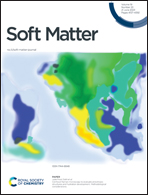Role of protein aggregate structure on the strength and underwater performance of barnacle-inspired adhesives†
Abstract
Nature employs protein aggregates when strong materials are needed to adhere surfaces in extreme environments, allowing organisms to survive conditions ranging from harsh intertidal coasts to open oceans. Amyloids and amyloid-like materials are prevalent and amongst the most densely bonded aggregate structures, though how they contribute to wet adhesion is not well understood. In this work, waterborne protein solutions of individual whey proteins are cured in place using varied temperature to produce model adhesives enriched in amyloid or non-amyloid aggregates. Dry adhesive strengths range from 0.2–1.5 MPa, while wet adhesive strengths range from 0–0.5 MPa across the tested proteins and processing conditions, highlighting that both proper protein selection and controlled aggregation extent are necessary for successful underwater performance. For bovine serum albumin, the amyloid-enriched adhesive was able to retain ca. 500 kPa bond strength underwater throughout extended immersion and thermal degradation testing, while the non-amyloid adhesive weakened by up to 80%. As freestanding gels, higher temperature processing improved underwater stability for all the protein materials, with amyloid-rich structures remaining mostly water-insoluble after 30 days submerged in water. Protein-based adhesives with a controlled aggregate structure shed light on the ability of amyloid-containing materials to remain adhered underwater, a necessary trait for the survival of many organisms.



 Please wait while we load your content...
Please wait while we load your content...